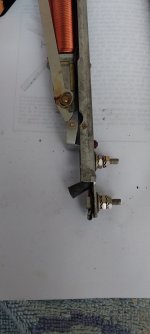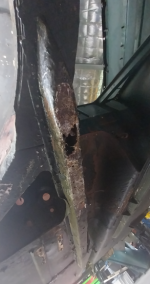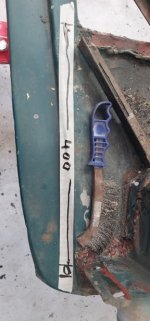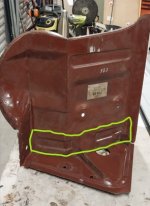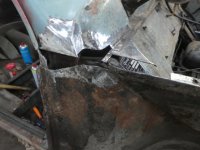Tinkered with the Ute semaphores today with success.
After reviewing the wiring diagrams and trawling through Google/YouTube videos, there was no logical explanation as to why there are four terminals on the Ute version of the semaphores. Two looked like wire connections the others just bolts. A Multimeter confirmed current flowed through the bottom two, which activated the solenoid and bulb.

With no evidence of power going to the top two terminals (?) it was assumed that they were either earths or mounting points. After carefully dismantling the flashing unit from the housing, it became evident that they were mounting bolts.
Mounting the flasher unit into a vice, power was connected to each of the two bottom terminals separately. As stated before, one operated the bulb and the second the solenoid. Both circuits worked perfectly independently. The two terminals were then configured into a parallel configuration with small jump wires. With power reapplied, the arm raised and the bulb glowed. The arm did however, raise slowly and not to its full height. From long ago foggy memory, I recalled this happening on other 203’s I’d seen.
As a precautionary measure, the semaphores will be fitted with solid-state flashing LED’s These will negate the need to run additional wiring and a flasher can unit etc.. At any time into the future, standard non-flashing Festoon bulbs can be re-installed. For some reason and I am assuming that the LED draws less current than the festoon bulb, thus supplying more current to the solenoid, which in turn enabled it to open to full height. (?)

To insert the new units into the existing housing, some slight modifications will need to be made.
The power source connections are at the base of the units within the sedan versions and the Ute version, enter through the rear of the housing. This will be overcome by re-routing the wires within the base of the units.
The Ute units are more rectangular in shape as opposed to the slightly tapered sedan version.


As are the internals of the units. This won’t be a problem as the arm recoil bush (Rubber grommet) can be trimmed to allow the arm to return to a lower position within the sedan housing.

Click on the image to play video.
A little knowledge can be dangerous at times, but it paid off this morning.
Cheers,
Dano
After reviewing the wiring diagrams and trawling through Google/YouTube videos, there was no logical explanation as to why there are four terminals on the Ute version of the semaphores. Two looked like wire connections the others just bolts. A Multimeter confirmed current flowed through the bottom two, which activated the solenoid and bulb.
With no evidence of power going to the top two terminals (?) it was assumed that they were either earths or mounting points. After carefully dismantling the flashing unit from the housing, it became evident that they were mounting bolts.
Mounting the flasher unit into a vice, power was connected to each of the two bottom terminals separately. As stated before, one operated the bulb and the second the solenoid. Both circuits worked perfectly independently. The two terminals were then configured into a parallel configuration with small jump wires. With power reapplied, the arm raised and the bulb glowed. The arm did however, raise slowly and not to its full height. From long ago foggy memory, I recalled this happening on other 203’s I’d seen.
As a precautionary measure, the semaphores will be fitted with solid-state flashing LED’s These will negate the need to run additional wiring and a flasher can unit etc.. At any time into the future, standard non-flashing Festoon bulbs can be re-installed. For some reason and I am assuming that the LED draws less current than the festoon bulb, thus supplying more current to the solenoid, which in turn enabled it to open to full height. (?)
To insert the new units into the existing housing, some slight modifications will need to be made.
The power source connections are at the base of the units within the sedan versions and the Ute version, enter through the rear of the housing. This will be overcome by re-routing the wires within the base of the units.
The Ute units are more rectangular in shape as opposed to the slightly tapered sedan version.
As are the internals of the units. This won’t be a problem as the arm recoil bush (Rubber grommet) can be trimmed to allow the arm to return to a lower position within the sedan housing.
Click on the image to play video.
A little knowledge can be dangerous at times, but it paid off this morning.
Cheers,
Dano

